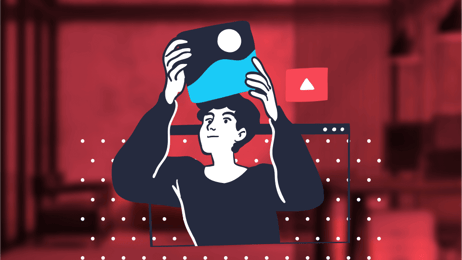Posting on social media without an overall strategy is like driving with a blindfold on.
Most likely, you’re going in the wrong direction, and it will cost you a lot of money.
A comprehensive B2B social media strategy should encompass creating and managing content that drives business growth and attracts more of your ideal customers. B2B social media initially qualifies as an awareness builder, a crucial first step in reaching your target audience. But when you have a comprehensive B2B social media strategy, then your social posts not only bring awareness but convert leads.
Let’s review the eight elements of a comprehensive B2B social media strategy that will help drive profitable conversions and impact the six levers of growth.
8 Elements A Comprehensive B2B Social Media Strategy Should Include
B2B social media strategy affects every corner of your business. The resulting benefits of a comprehensive B2B social media strategy include building trust with leads and clients, developing social proof, improving your business’ reach and impact, and improving your customer experience.
Your strategy will look different from your neighbors’, depending on your business, demographic, and industry. But no matter your business, there are must-haves for a comprehensive B2B social media strategy.
Heads up - we’re not a social media agency; we’re a growth marketing team. At Lean Labs, we look at social media through the lens of the six levers of growth: awareness, acquisition, activation, revenue, retention, and reputation. Being growth marketing-focused means that everything that we discuss in this article will apply to the six levers of growth so you can start taking action with your team and trust that it will impact your growth.
Prerequisites To Your B2B Social Media Strategy
Let’s check some items off of our list - before building your B2B social media strategy; you should have the following already completed:
- Branding guidelines set in stone
- A clear brand voice
- Branded storytelling narrative
- Budget allotment for social media management and content creation
- A deep understanding of your customers’ fears, motivations, and needs
Completing these actions first ensures that you have established a good foundation, so your strategy is on-brand and addresses your customers’ needs.
1. Prioritized Platforms Ranked By Impact
When developing a B2B social media strategy, it’s crucial to start on the right foot. Each social media platform has a different demographic and culture that may or may not suit your business. By choosing the right social media platforms for your business to launch on, you’re one step closer to using social media to enable the six levers of growth.
Determining the pros and cons and potential ramp-up time per platform helps prioritize which platforms are best for your company. Your neighbors’ business may work amazingly well on Instagram, but LinkedIn may be the better platform to launch on for your business initially.
LinkedIn
LinkedIn is where the B2B business owners are. As the ultimate networking site, using LinkedIn is an excellent opportunity to create thought leadership, encourage employee engagement, and reach a B2B decision-maker demographic. This platform works best for engaging stories, workplace lessons, thought leadership content, and multimedia content.
Twitter
Twitter is for sharing quick, valuable nuggets of information. It’s where trends start and where customers’ questions can be quickly answered. This platform is perfect if your leadership team has short, valuable information to share, and someone can engage in conversations throughout the day.
Facebook
If you’re looking to invest in ads, create a private community, or even show your company’s personality a bit - Facebook is the platform to do it on. Facebook is an excellent place to reach a B2B audience, especially if you have a budget for paid media. Due to Facebook’s recent algorithm and ad-focused policy changes, organic content is becoming more competitive for B2B companies. At a minimum, Facebook is a great resource for B2B companies to build social proof with the “reviews” functionality and quickly answer customer questions through Messenger.
Instagram
Bought by Facebook in 2012, Instagram has gone through similar changes regarding the focus on advertising. Instagram is the place for your company if your B2B company wants to focus on visual content rather than text-based storytelling, has staff to manage engagement, and is open to advertising. For your company, this may mean creating visual, educational content such as infographics or creating cool videos showing the behind-the-scenes of your business. Utilizing the latest Instagram updates and features is essential for your business, such as Reels and Shoppable Posts, which are must-haves in your Instagram strategy.
YouTube
YouTube is the perfect platform for in-depth, long-form video content. The B2B companies that thrive on YouTube have team members and leadership who are comfortable on camera and have a website blog strategy to complement their videos. This platform is great for tutorials, deep dives, and educational content, along with creating opportunities for your customers to get to know your team.
TikTok
How could we leave out TikTok? TikTok is commonly thought of as “where all the kids are,” but the platform demographics continue to expand. TikTok is great for B2B companies that are readily available to quickly make short-form video content. TikTok is second to Twitter for quickly trending content and is, by far, the best platform for potentially viral content.
2. Dividing Up Your Content Categories
Every piece of content your company posts on social media should be curated to speak to your buyers’ journey. Social media is an awareness builder at its core, but when you post with your buyers’ journey in mind, you maximize your opportunities for acquisition and activation.
For every post to be curated and intentional, there needs to be a structure to your content creation. Similarly to blog posts, each post should have its own category that serves a specific purpose.
Let’s say you want four content categories that bring more than awareness to your B2B company.
For example, you can divide up your content into these four main categories:
- Educational content
- User-generated content
- Social proof content
- Instructional product videos
When using these four categories, you’re not only discussing what your company offers. You’re educating and showcasing the successful use cases of how others use your product. This builds trust with your audience because you’re showing your positive reputation and providing them with educational information that will help them in the early stages of their buying decision.
3. Content Creation & Scheduling Process
One of the biggest problems companies face when it comes to posting on social media is consistency. It’s challenging to keep up with a content strategy if you don’t have the budget or personnel to stay on top of it consistently.
Your strategy should be 100% realistic to your budget, end goals, staffing, and commitment to social media to combat this common problem. Consider what is realistic for you now but also in 10 months from now. Maximizing your efficiency and consistency with posting on social media increases your brand awareness, positively impacting the rest of the levers of growth.
Creating a content creation schedule that is easy to maintain in the short and long term is the essential first step. A popular way to design a content creation schedule is to start by calculating post creation time and analyzing your overall budget for social media. From there, you can figure out how frequently you would like to post.
Once the content creation process is planned, you can strategize which scheduling platforms work best. There are tons of options out there, but some of the top choices are Later, Buffer, and Hootsuite. If you already use the HubSpot CRM or CMS, then HubSpot Social is a natural add-on to keep your data all in one place.
Let’s review a real-world example of what the content creation and scheduling portion of your B2B social media strategy might look like for one platform:
- # of Posts per Batch: 12 posts
- Post Frequency: 12 posts per month - M-W-F during optimized times
- Estimated Time Per Batch: 3 hours at $20/hourly
- Review Time: 1 hour a month by management
- Scheduling Time Per Batch: 1 hour at $20/hourly
4. A Timeline of Social Media Roll Out Phases
Utilizing roll-out phases is a technique to stagger your launches on different platforms. Establishing performance milestones is an excellent way to sensible roll out on new platforms once you have a proven recipe for success.
Here is what a social media rollout phase would look like:
Phase 1: Roll out Facebook for two months. If engagement consistently averages above 10% with over 100 total clicks - then move to phase 2. If not, continue to work on those goals until met.
Phase 2: Roll out LinkedIn in addition to Facebook, measure performance in 2 months. If engagement and click goals are met, move to phase 3, etc.
In addition to tracking engagement and website clicks, your team can dive deeper into your growth metrics. Creating milestones that social media has to hit based on the six levers of growth maximizes your social media budget and efficiency. When your platforms perform well on awareness, acquisition, activation, retention, reputation, and revenue - then you’ll have a big picture of how social media is affecting your business.
5. Content Adjustments For Each Platform
Every social media platform is extensively different. Each platform has different content requirements, demographics, and culture. That’s why adjusting your messaging for each platform is crucial to optimizing social media performance.
Slightly differentiating your brand voice based on the platform is a way to engage each platform’s audience more without creating vastly different content.
A live example of this is the differences between LinkedIn versus Instagram. Instagram is a visual feed-based platform, so viral posts are videos or pictures. On the other hand, LinkedIn is a very text-based storytelling platform. Stories with a captivating first line on LinkedIn have a high probability of getting more engagement than reposting an Instagram post with a lackluster caption.
Let’s say you have an Instagram post that you want to adjust for LinkedIn. You can write a more detailed story about the topic as a mini-blog or a LinkedIn status. Taking that same idea but adjusting your delivery is a great way to create an abundance of content and brand awareness.
6. Social Media Trend Strategy
Following trends left and right can easily distract you from your original social media strategy; unless you plan for it ahead of time.
When a new sound or video style goes viral, the first people to jump on it often go viral. There are even apps designed to alert you when an up-and-coming trend is getting popular so you can take advantage of it.
Planning for this strategic advantage ahead of time is something that many B2B companies do not do. This is often because trend inclusion isn’t something that many B2B companies plan and budget for ahead of time.
A real-life example of this in your B2B social media strategy could be as simple as this:
Extra hours: 2 hours flexible monthly hours for trend inclusion - expedited review process by XYZ Manager within 24 hours.
The inclusion of a social media trend strategy keeps your initial plans on track while enabling you to stay updated with new features and trends that can put your company in the spotlight. Trend inclusion can significantly impact your brand awareness if you can catch trends on an upward trajectory, therefore funneling more leads towards acquisition and activation.
7. Conversion Opportunities
The average attention span in 2020 was 8 seconds. This leaves B2B leaders wondering, “how do I keep that attention, get more, and convert my social media followers into customers?”
People want to engage with your brand, but converting your followers or viewers to customers through social media requires more than just posting. Without a conversion funnel that speaks to your buyers’ journey and leads a viewer through the six levers of growth, conversion opportunities are often lost.

On social media, many B2B companies struggle with getting people over to acquisition. Many viewers and followers get stuck in awareness and never take action. For your B2B social media strategy, it’s crucial to have clear and simple call-to-action prompts. The more obvious, the better, you want your social media to be as easy as possible to take action.
In your B2B social media strategy, creating conversion opportunities may look like:
- Blog previews with “Click To Read The Full Article” CTAs
- Advertising lead magnets with tracking links
- An Instagram post including “Click the link in my bio to book a call” in the caption
- Qualifying for the “swipe up” Instagram Story feature so you can put direct links on your Instagram Stories
- Posting webinar previews and leading people to your “Register here” prompt
- Creating a shoppable feed in your profiles, i.e., Facebook and Instagram, where leads can easily buy without leaving the app
Your website strategy is the other half of the ‘conversion opportunity’ coin. If your social media team and website team are not on the same page, then your conversion rates will not be optimized, and your followers will rarely go into acquisition and activation.
8. Growth Analytics Tracking
Chances are you’ve heard about analytics and metrics before. Marketing companies talk about metrics and analytics all the time and how it impacts your business.
The metrics we recommend focusing on specifically are growth metrics.
At Lean Labs, we’re all about growth marketing and using the right metrics to match. That’s why we use the six levers of growth to gauge B2B company performance.
Here are some examples of social media growth metrics you could use in your B2B social media strategy, paired up with the six levers of growth:

Measure Up Your B2B Strategy Performance
Does your B2B social media strategy impact your business’ growth positively? That’s the million-dollar question.
Many B2B leaders get stuck in managing metrics that don’t speak to their company’s growth. That’s why we only recommend utilizing the six levers of growth; because it covers every aspect of your business’ growth while helping you strategize for your traffic sources.
Utilizing the six levers of growth in your strategies will help improve your conversion rate and customer experience. Now you know what a B2B social media strategy should look like - the next step is to see how your performance stacks up with the six levers of growth. Next time you re-strategize, remember the six levers of growth, and it will not steer you wrong.




